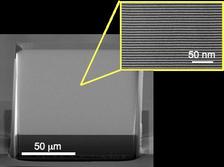Multilayer Laue Lens (MLL): The lenses are typically 10–100 μm tall (aperture size), 100 μm wide and several μm thick (optical depth) with focal lengths of 1–10 mm. Focusing and imaging with 8.4 × 6.4 nm resolution has been demonstrated (Credit: S. Bajt, DESY).
A group of scientists, headed by Saša Bajt and mainly from DESY is one of this year’s winners of the ‘Microscopy Today Innovation Award’ for their work on “High numerical aperture, high efficiency X-ray lenses”. Each year, the Microscopy Today magazine selects the best new development in microscopy. The development of the lenses was judged as one of the ten best microscopy innovations in the 2018 competition and the prize will be awarded during the 'Microscopy & Microanalysis 2018' meeting in Baltimore (US). Microscopy Today is the official magazine of the Microscopy Society of America (MSA).
The penetrating nature of hard X-rays and their short wavelengths below about 0.1 nm make them attractive for imaging of objects such as biological cells at resolutions beyond that of visible light and without sectioning or thinning the sample as needed for transmission electron microscopy. These properties of X-rays also make them difficult to focus. Soft X-rays can be focused with thin diffractive Fresnel zone plates (similar to a circular transmission grating), but to focus hard X-rays very high aspect ratio diffracting structures are required. The scientists made several innovations in the fabrication process to achieve high efficiency and to extend the numerical aperture (NA) far beyond what was previously possible, to enable imaging at spatial resolutions below 10 nm, with diffraction efficiencies exceeding 80%.
Awardees: Saša Bajt (DESY), Andrzej Andrejczuk (University of Bialystok, Poland), Sabrina Bolmer (DESY), Henry Chapman (DESY and Univ. Hamburg), Andrew Morgan (DESY), and Mauro Prasciolu (DESY).








